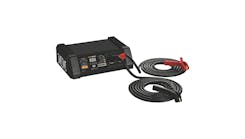Editor's note: This article was originally published Nov. 1, 2010. Some of the information may no longer be relevant, so please use it at your discretion.
Before overdrives became a common feature and most transmissions had only three or four gears, driving was a much busier affair. The idea of a 70 mph cruise down the highway at moderate revs was virtually non-existent, because the low rear-end ratio, while ensuring a quicker launch off the line, kept the engine buzzing, even in top gear.
Eventually that high-rpm drone could drive you batty, along with consuming more fuel and adding wear and tear.
Of course, the introduction of an overdrive gear in newer five- or six-speed transmissions minimized these problems. But retrofitting an older car, especially a classic muscle car, doesn't always make sense. After all, most of the older trannies basically are bulletproof, and you wouldn't want to lose their feel and look, which adds to the intrinsic value of the car. Why replace those good four gears for a newer trans that merely adds one gear, but doesn't shift as well, nor handle as much power and abuse?
As an alternative, you can install a Gear Vendors gear splitter. The unit consists basically of a self-contained auxiliary transmission with planetary gears like those found in modern automatic transmissions. It fits in line between the transmission (either manual or automatic) and the driveline.
Because the unit has a pressurized lubrication system driven by an internal pump, it doesn't share any of the fluids of the vehicle's OE components. Upon activating the unit with a switch on the shifter or dashboard, a solenoid closes a valve, changing a path of oil to hydraulically hold a clutch pack that drives the planetary gears. These gears reduce the drive ratio 22 percent (0.78:1), so you have intermediate ratios to maintain engine rpm at the optimum level.
This setup also reduces the power output required to maintain driving speed in a specific range by allowing the engine to turn at a lower speed than the driveshaft. What that means on the road is that now the car is able to go 70 mph at about the same rpm as at 55 mph without overdrive.
Besides making for a much more pleasant cruise, a gear splitter is one of the greenest aftermarket accessories available. Because the engine runs slower at all given speeds when the overdrive is engaged, it consequently uses less fuel and creates less pollution and fewer greenhouse gases.
The Gear Vendors unit can be engaged in any gear, so it actually doubles the number of ratios available in any transmission. Basically it can turn a three-speed tranny into a close-ratio six-speed, divvying up the powerband into smaller increments. Gear Vendors offers gear splitters for all major transmissions and has a wide range of applications. For instance, the specific install shown here is on a 727 Torqueflite, which is found on Chrysler A, B, C and E Bodies. It's also used in the Plymouth Fury (I through III models), Sport Fury, VIP and Suburban wagon Dodge Monaco and Polara Chrysler Newport, 300, New Yorker and Town Country.
In addition to slowing down the motor for better fuel economy and improved drivetrain durability, there's another potential benefit for vintage muscle cars when under hard acceleration with a manual transmission. Typically when you want to show off or are trying to lay down a good run at the strip, the One-Two shift is where the automatic guys blow on by. That's because by the time your tires hook up and you get the car driving down the lane, you immediately have to clutch, and that gets the chassis all unloaded and squirrelly again.
With the Gear Vendors unit, though, you are 22 percent (or even more, depending on the gear ratios) farther down the track and all the way through the first two ratios before you have to clutch. That's where the clutchless, tire-barking shift function comes in real handy. With a Gear Vendors behind the tranny you can hit the button on the shifter before you ever leave the line (or traffic light). Then you drop the clutch in first and the car will rev through first gear and then automatically (or you can hit it manually) shift to first-over, all without touching the clutch pedal.
The Gear Vendors Under/Overdrives are found in a number of applications beside muscle cars, including certain types of passenger cars, diesel pickups, delivery trucks, RVs and even modern cars such as the Callaway Corvette.
Installation of a gear splitter consists basically of bolting on a replacement housing, which has an eight-hole pattern to receive the overdrive. You then tighten the eight nuts and take the driveshaft with the new yoke (included) to the local driveshaft shop to be shortened (as per the instructions). One of the most important aspects to keep in mind is precise alignment of the driveline angles to ensure vibration-free operation. Plug in the electronics and fill the overdrive with the recommended lube, and you're ready to roll.
The electronic control box is installed inside the cockpit, under the carpeting at the toe-board. For a manual transmission, the switch for activating the unit mounts on the gearshift lever. For automatics, a foot-operated switch is used on the left side of the driver's footwell (such as the old headlight dimmer switch).
The electronic module controls the splitter so that it engages at the proper speed and turns off automatically (at about 20 mph), in case you forget. The module also locks and unlocks the factory torque converter in an automatic. Overall, the gear splitter integrates seamlessly with the factory driveline and is easy to operate when it comes time to drop the engine revs for long-range cruising or improve acceleration off the line. Overall, the change in driving experience is dramatically different, with a number of benefits your customers will no doubt appreciate.
Steve Temple is a freelance technical writer and photographer with more than 25 years of experience. He has served as director of sales and marketing for Shelby American and as online editor for major magazines such as Hot Rod, Car Craft and Rod Custom.







